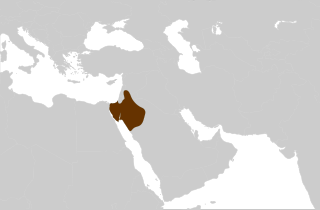
The Arabs, also known as the Arab people, are an ethnic group mainly inhabiting the Arab world in West Asia and North Africa. A significant Arab diaspora is present in various parts of the world.

The Arabian Peninsula, or Arabia, is a peninsula in West Asia, situated northeast of Africa on the Arabian Plate. At 3,237,500 km2 (1,250,000 sq mi), comparable in size to India, the Arabian Peninsula is the largest peninsula in the world.

The Nabataeans or Nabateans were an ancient Arab people who inhabited northern Arabia and the southern Levant. Their settlements—most prominently the assumed capital city of Raqmu —gave the name Nabatene to the Arabian borderland that stretched from the Euphrates to the Red Sea.

ʿAsir, also spelled Aseer, is a province in the southwest of Saudi Arabia, which is named after the ʿAsīr tribe. It has an area of 76,693 square kilometres (29,611 sq mi), and an estimated population of 2,024,285. 'Asir is surrounded by Mecca Province to the north and west, Al-Bahah Province to the northwest, Riyadh Province to the northeast, Najran Province to the southeast, and Jazan Province and the Yemeni Muhafazah (Governorate) of Sa'dah to the south.

Arabia Petraea or Petrea, also known as Rome's Arabian Province or simply Arabia, was a frontier province of the Roman Empire beginning in the 2nd century. It consisted of the former Nabataean Kingdom in the southern Levant, the Sinai Peninsula, and the northwestern Arabian Peninsula. Its capital was Petra. It was bordered on the north by Syria, on the west by Judaea and Egypt, and on the south and east by the rest of Arabia, known as Arabia Deserta and Arabia Felix.

Arabia Felix was the Latin name previously used by geographers to describe South Arabia, or what is now Yemen.

Haʼil is a city in north-western Saudi Arabia. It is the capital and largest city of Ha'il Region, with a population of about 498,575 (2022).

South Arabia is a historical region that consists of the southern region of the Arabian Peninsula in Western Asia, mainly centered in what is now the Republic of Yemen, yet it has also historically included Najran, Jizan, Al-Bahah, and 'Asir, which are presently in Saudi Arabia, and Dhofar of present-day Oman.
Mavia was an Arab queen, who ruled over the Tanukhids, a confederation of semi-nomadic Arabs, in southern Syria, in the latter half of the fourth century. She led her troops in a rebellion against Valens, riding at the head of her army into Phoenicia and Palestine. After she reached the frontiers of Egypt and repeatedly defeated the Roman army, the Romans finally made a truce with her on conditions she stipulated. Following her victory, Mavia was powerful enough to be able to dictate the terms of negotiations. She demanded that a certain orthodox Christian monk, Moses, be named as bishop over her people. The Romans later called upon her for assistance when being attacked by the Goths, to which she responded by sending a force of cavalry.
The Desert of Paran or Wilderness of Paran, is a location mentioned in the Hebrew Bible. It is one of the places where the Israelites spent part of their 40 years of wandering after the Exodus, and was also a home to Ishmael, and a place of refuge for David.

Pre-Islamic Arabia, referring to the Arabian Peninsula before Muhammad's first revelation in 610 CE, is referred to in Islam in the context of jahiliyyah, highlighting the prevalence of paganism throughout the region at the time.
The Arabian Peninsula, much of which now comprises the Kingdom of Saudi Arabia, has always held a mysterious attraction for European explorers. Until modern times it was uncharted, inaccessible, dangerous and forbidden. Some areas remain dangerous and forbidden to the present day. Mecca and Medina are holy cities in Islam and are forbidden to non-Muslims.
It is believed that Jews began migrating to the Arabian Peninsula in as early as the 6th century BCE, when the Babylonian conquest of Judah triggered a mass Jewish exodus from Judea in the Land of Israel. Over time and through successive exiles, the local Jewish tribes, who were concentrated in the Hejaz and partly in South Arabia, established themselves as one of the most prominent ethno-religious communities of pre-Islamic Arabia. Likewise, Judaism, which had been introduced as one of the few monotheistic religions in the region, stood as a deviation from the typical polytheistic practices of Arabian paganism. These Jewish tribes continued to have a presence in Arabia during the rise of Muhammad, who founded Islam in the 7th century CE. Muhammad's interaction with the Jewish community is documented to a considerable degree in Islamic literature, including in many ahadith. The Jewish tribes of the Hejaz are seen in Islam as having been the offspring of the Israelites/Hebrews. Two of Muhammad's wives were Jewish: Safiyya bint Huyayy and Rayhanah bint Zayd, both of whom belonged to the Banu Nadir by birth, though Rayhanah's status as a wife is disputed.

The Nabataean Kingdom, also named Nabatea, was a political state of the Nabataeans during classical antiquity.
The Roman presence in the Arabian Peninsula had its foundations in the expansion of the empire under Augustus, and continued until the Arab conquests of Eastern Roman territory from the 630s onward.

The Emirate of Jabal Shammar, also known as the Emirate of Haʾil or the Rashidi Emirate, was a state in the northern part of the Arabian Peninsula, including Najd, existing from the mid-nineteenth century to 1921. Jabal Shammar in English is translated as the "Mountain of the Shammar". Jabal Shammar's capital was Ha'il. It was led by the monarchy of the Rashidi dynasty. It included parts of modern-day Saudi Arabia, Iraq, and Jordan.

Arabian Sands is a 1959 book by explorer and travel writer Wilfred Thesiger. The book focuses on the author's travels in the Arabian Peninsula between 1945 and 1950, and details his two crossings of the Empty Quarter undertaken between 1946 and 1948. Thesiger’s first crossing, from Mughshin in Oman to Liwa across the eastern sands, was followed by a crossing of the western sands from Manwakh in Yemen, via Laila, to Abu Dhabi.
Christianity was one of the prominent monotheistic religions of pre-Islamic Arabia. Christianization emerged as a major phenomena in the Arabian peninsula during the period of late antiquity, especially from the north due to the missionary activities of Syrian Christians and the south due to the entrenchment of Christianity with the Aksumite conquest of South Arabia. Sites of Christian organization such as churches, martyria and monasteries were built and formed points of contact with Byzantine Christianity as well as allowed local Christian leaders to display their benefaction, communicate with the local population, and meet with various officials. At present, it is believed that Christianity had attained a significant presence in Arabia by the fifth century at the latest, that its largest presence was in Southern Arabia (Yemen) prominently including the city of Najran, and that the Eastern Arab Christian community communicated with the Christianity of the Levant region through Syriac.

The Battle of Cana was fought between Greek Seleucid Empire under king Antiochus XII Dionysus, and the Arab Nabataean Kingdom. Cana is an unknown village; scholars place it somewhere south or southwest of the Dead Sea.













